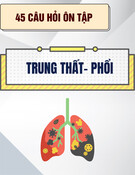
75
SỐ 02 (55) - 2024
TẠP CHÍ Y DƯỢC CỔ TRUYỀN VIỆT NAM
Evaluating the sub-chronic toxicity of the
Boga -TN tablets in experimental animals
Pham Thuy Phuong1, Nguyen Pham Thu May1 ,
Bui Hoang Anh1 Nguyen Pham Ngoc Mai2, Trinh Vu Lam1
1Viet Nam University of Traditional Medicine
2Hanoi University of Science and Technology
SUMMARY
Objective: To assess the sub-chronic toxicity of Boga-TN tablets in experimental animals to determine
the effects of the drug on the hematological and biochemical indices.
Subjects and Methods: Sub-chronic toxicity experiment was carried out in compliance with the
guidance of the World Health Organization. Wistar rats (160 - 200g) of both genders, provided by the
Laboratory Animal Center, Dan Phuong district, Hanoi were used.
Results: The study was carried out in Wistar rats for 4 consecutive weeks by oral administration at
the doses of 0.77 and 2.32g/kg/day. After treatment, no significant treatment-related abnormalities were
observed at both doses of Boga-TN, compared to the control group, except for the white blood cells, with
lower neutrophil but higher lymphocyte values observed in the treated animals. Histopathology assessment
did not show any significant variation between control and treatment groups during the study period.
Conclusions: Boga-TN with a dose equivalent to the proposed clinical dose and 3 times the clinical
dose did not cause any significant toxicity resulting in death, or produce any hematological, serum chemical
alteration, and histo-pathological derangements. However, significant reductions in the levels of WBC,
lymphocytes and increased levels of neutrophil in treated groups were detected after 4 weeks of treatment.
Keywords: Sub-chronic toxicity, Boga-TN tablets, experimental animals.
Corresponding author: Pham Thuy Phuong
Phone number: (+84) 983654033
E-mail: Thuyphuongydhctvn@gmail.com
DOI: https://doi.org/10.60117/vjmap.v55i2.287
Received: 21/02/2024
Reviewed: 02/04/2024
Accepted: 01/08/2024
INTRODUCTION
The liver is one of the largest organs in the
human body. Liver diseases can be caused
by various factors that may damage the
liver, such as alcohol, viruses, obesity, drugs,
or chemicals, leading to liver cirrhosis, non-
alcoholic, and alcoholic fatty liver disorders
[2]. Vietnam has a high prevalence of liver
diseases and one of the highest rates of chronic
HBV infection and alcohol consumption in the
world [3]. Hepatic toxicity can occur through
several mechanisms, including Cytochrome
P450 activation, lipid peroxidation, induction
of nitric acid synthase, mitochondrial
dysfunction, activation of pro-inflammatory
mediators, and bile acid-induced liver cell
death.
Herbal medicines play a vital role in the
treatment of various diseases. Recently,
there has been a shift from using only
synthetic medications to combining them
with traditional herbal drugs to control
various conditions. Particularly, many plants
have been included in the treatment of liver
disorders [4]. As the usage of herbal medicine
increases, more scientific evidence regarding
the safety of herbal products is required. They
are generally considered safe, which might






























